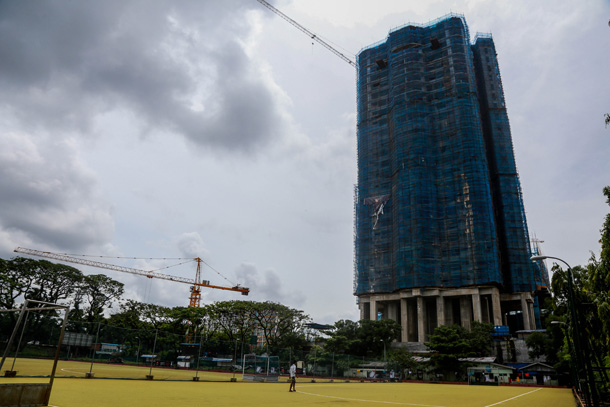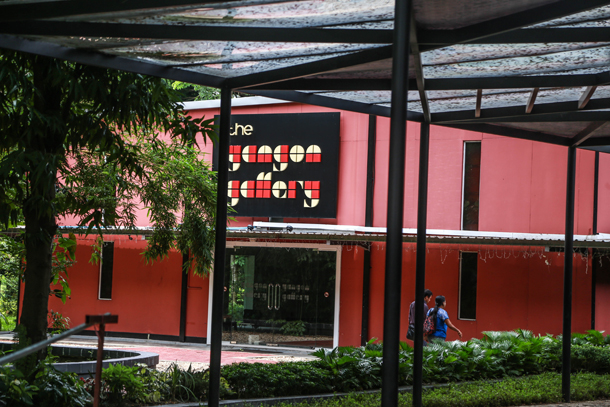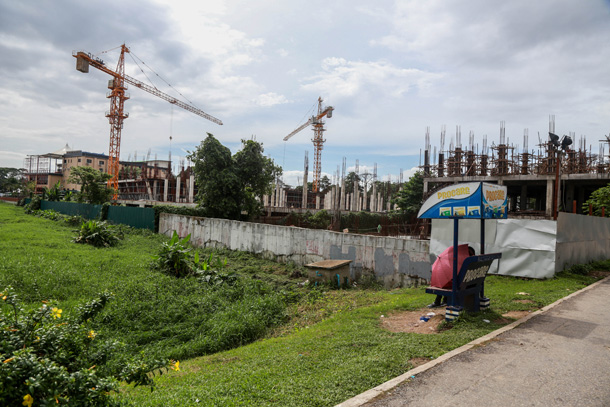Kyaw Zwa Moe: Welcome to Dateline Irrawaddy! This week, we’ll discuss public spaces in Yangon. Public spaces like gardens, sports grounds, streets and lakes used for firefighting purposes were grabbed through various methods under Yangon’s previous government. We’ll discuss how we can get those public spaces back and prevent similar land grabbing in the future. Yangon divisional lawmaker U Nay Myo Kyaw (aka) U Nay Phone Latt of Thingangyun constituency and Irrawaddy senior reporter Ko Kyaw Phyo Tha will join me for the discussion. I’m Irrawaddy English editor Kyaw Zwa Moe.
Ko Nay Phone Latt, last week you put forward a proposal to Yangon divisional parliament to ensure that people get public spaces back. Fifteen lawmakers seconded your proposal and it was approved. I read your article in which you said inhumane housing projects that do not take public spaces into consideration have mushroomed in our country. Public spaces were grabbed and used for commercial purposes by businessmen who worked hand in glove with civil servants of the previous government, and also probably with municipal staff. Public spaces are rare now in Yangon, and so you submitted the proposal. How bad do you think the situation is?
Nay Phone Latt: I submitted the proposal based on my experiences in Thingangyun constituency. I carried out a survey and listened to the voices of my constituents. Most of them complained that there was no children’s playground. I asked if there aren’t any and they replied that there used to be playgrounds. There are four wards—16/1,2,3,4 in our neighborhood and there used to be a pitch in each ward. But now, pitches in wards 1, 2 and 4 are gone. [Concerned authorities] developed those pitches into plots, authorized them as residential and sold them. Now all the pitches have turned into residential buildings.
KZM: Who sells and who buys?
NPL: I don’t know exactly. The seller can either be the municipality or the Department of Human Settlement and Housing Development [under the Construction Ministry]. In our country, public spaces are registered under departmental ownership under municipalities, the Human Settlement and Housing Development Department, the War Veterans Organization, the Cooperatives Department and so on. Perhaps, they really think they own them and therefore sell those lands, which has been the case in ward 16. Now only ward 16/3 has public space.
In my proposal, I mentioned the case of AKK Shopping Mall in Thingangyun Township as an example. There is a street by AKK Shopping Mall where the municipality [Yangon City Development Committee] has built a two-story office. A total of 15 lawmakers debated the proposal, mentioning similar cases in their respective constituencies. In the case of Kantharyar Garden in North Okkalapa Township, there is a statue of Bogyoke [Gen Aung San] riding a horse. The statue has been neglected [since the garden has been turned into an amusement park]. As for Theinbyu sporting ground, the British used it as a shelter in case of disaster. It is not that public spaces are kept with no purpose. It is not that spare lands are named as sport grounds. They have certain purposes.
KZM: For the sake of people?
NPL: Yes, they are very important for the people. Playgrounds and gardens are important. And lakes are also important—they can be used to put out fires and for drinking. [Authorities] only care for money and even sell the lakes, filling them with earth. We have seen many cases. I’m worried that gradually there will not be any public spaces left if no action is taken.
KZM: We have constantly covered this issue. Drawing a conclusion from what Ko Nay Phone Latt has said, it seems that there are many private companies, businesses and restaurants doing business in public spaces. Can you name some of them for public knowledge, Ko Kyaw Phyo Tha?
Kyaw Phyo Tha: There are many of them, but to name a few significant ones in Yangon, the first one is Theinbyu Stadium, which Ko nay Phone Latt has mentioned.
KZM: What is being constructed there?

KPT: A condominium is being constructed there. It is substantially complete. It is a really high building. We don’t know who the developer is, but it is almost complete. The second one is Mya Kyun Tha. It was a pure park when we were young. But now, there are construction sites along its two sides and the place no longer looks like a park. Another one is People’s Square. Shops are rented there.One of the most striking buildings there is Culture Valley [shopping mall]. Public spaces should be only for members of the public. Mainly, they should be places where the public can exercise, have social gatherings and where children can play freely. As far as we are concerned, amusement centers will be built in Mya Kyun Tha. So, those places are no longer meant for needy people to use?
KZM: Because operators of those amusement centers will charge, right?
KPT: Yes, this has raised question.
KZM: Speaking of Mya Kyun Tha, we have learned that there are eight companies operating on large areas of land there and they have rented the land for 60 years. How can this be solved? Is it easy to claim it back for public use as Ko Nay Phone Latt has proposed? Cronies who have strong ties with the previous government have taken all those places. For example, People’s Square houses Yangon Gallery which is said to be owned by the son of army chief Snr-Gen Min Aung Hlaing. How can the Yangon divisional government and chief minister Ko Phyo Min Thein claim them back through negotiations?

NPL: In my proposal, I mainly urged for two things—one is to prevent commercial use of public spaces in the future, to prevent it by law so that no one can touch public spaces like sports grounds and gardens [for their personal benefits]. Another thing is—as Ko Kyaw Phyo Tha has said—many public spaces have been turned into buildings, and some of them are already established now. I understand that the government has difficulties handling these cases. So, I asked in my proposal to do whatever possible to probe into these cases and give public spaces back to the public.
KZM: Unless those buildings are big, high-rises—such as 20 stories. But if they are just small buildings like 1-story or otherwise, the government should take back the land and give the businessmen another place.
NPL: In my proposal, I said they could take action in line with what is possible. I don’t want the Yangon divisional government to be concerned about the cost of demolishing those buildings, but I want them to consider the potential benefits—as far as health, education and socializing—of returning those public spaces to the people. Some [government officials] think it is a waste of money to demolish those buildings. Let it be if they are really high and big structures. But those that are not high should be given back to the public. They have more important value than the monetary value of the buildings built on them.
KZM: They have value to public health and have, in other words, been stolen from the people. Ko Kyaw Phyo Tha, you have talked to urban planning experts. Do you see any means to get them back?
KPT: It is not that gardens and playgrounds are built with no purpose. As Ko Nay Phone Latt has put it, the land that is left after building a town is used as public space, playgrounds or parks. They are designed for the public because people really need them. The government and concerned companies should compensate a place for the people.
KZM: Companies have full responsibility.
KPT: Yes, they do. Green spaces are necessary for a city to achieve systematic development.
KZM: Yangon Chief Minister Ko Phyo Min Thein has told reporters he would rebuild Yangon as a green and people-friendly city. But, he alone can’t do this. It concerns the entire divisional government. Yangon Mayor U Maung Maung Soe raised objections when you submitted your proposal. It seems that he thinks that building municipal buildings in public spaces must be accepted. He has a different view.
NPL: When the mayor said so, I immediately responded because this view is potentially dangerous. Public spaces and public areas can’t be used in the interest of individuals, organizations or departments. They must be for the public. So, I don’t accept the view that it is fair for the Human Settlement and Housing Development Department or municipality to build state-owned buildings in public spaces. That view can’t be accepted. If we accept that view, government departments will build offices in public spaces in the future; for example, township administrators might build offices in parks and municipalities on streets. As it is a potentially dangerous concept, I reacted immediately that day.
KZM: The Yangon divisional parliament has approved your proposal with a majority of votes. But if the government can’t handle it in short time, what are you planning to do?
NPL: The parliament has a Government Guarantees, Pledges and Undertakings Vetting Committee. The committee will check if the promises made by the government in response to our proposals are fulfilled. And personally, I’ll do checks and balances on it. If nothing happens, I as a lawmaker can ask questions or submit proposals again at the next session of parliament. There is no specific law regarding public spaces in our country. There are some provisions in municipal law that say no one shall build buildings overlooking or overhanging public streets without the approval of the Yangon City Development Committee. It can be interpreted that it could be done if the committee approves. Such provisions should be changed. I am thinking parliament should adopt a law to protect anyone from using public spaces for commercial purposes.

KZM: Not only to mention public spaces, there is no transparency in the business transactions of cronies. Ko Nay Phone Latt, how do you define public spaces?
NPL: I like Singapore’s definition of public spaces. They really care about public spaces. They define ‘places’ as—‘P,’ for people plus programming. They don’t just grow trees in public spaces. They feature programs such as skating and cycling contests. This practice has become slightly popular in our country—singing songs and playing guitars. ‘L’ is for lush landscaping. ‘A’ is for accessibility. Even if there are parks, it is not convenient if parks are not easily accessible. ‘C’ stands for comfort—those places must enable people to relax comfortably. ‘E’ means excellence in design—they are designed beautifully to attract passersby.
KZM: They are made to be attractive!
NPL: Yes, attractive designs are incorporated. ‘E’ also stands for eye for details—it means every detail is considered to engage the people, to attract even the people who do not want to take a rest. ‘S’ stands for sense of delight—it means public spaces must be able to make people happy. And it also stands for sharing of spaces. We have to learn this and it will be good if we can apply it here.
KZM: Ko Nay Phone Latt, I am afraid we have to wait some time before this happens. Thank you for your contributions.

















